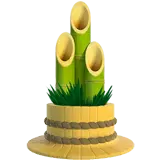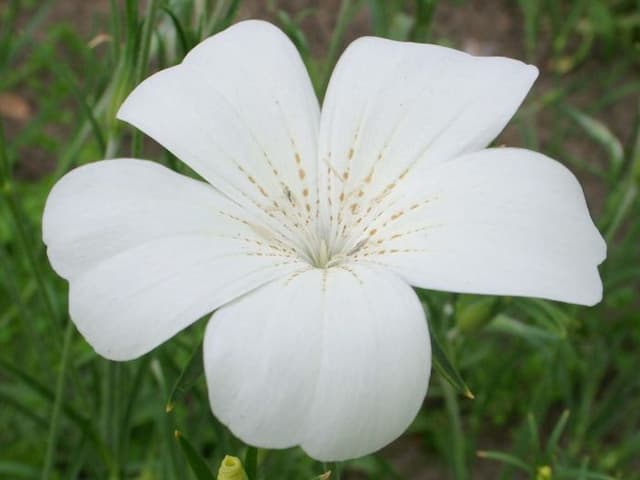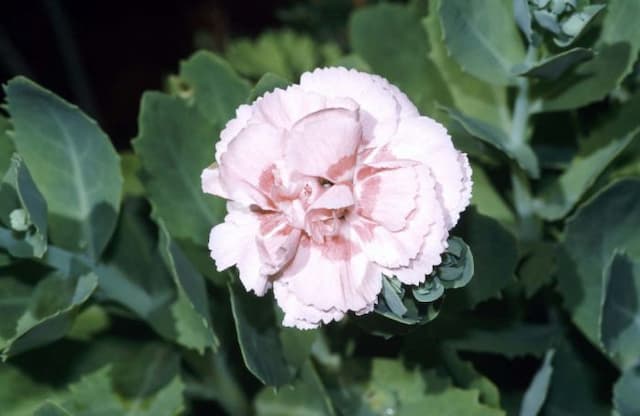Pink Dianthus 'Coral Reef' (PBR) (Scent First Series) (p)

ABOUT
Dianthus 'Coral Reef' is an ornamental plant known for its striking and distinctive flowers. It is part of the Scent First Series, which highlights its fragrant nature. This cultivar exhibits lush green foliage that forms a neat and compact tuft as the backdrop for its floral display. The flowers themselves are truly the stars of this plant. They possess a stunning coral pink hue with contrasting, near-white ruffled edges giving each petal a frilly, decorative appearance. Some blossoms may feature a subtle graduation of color, intensifying to a deep, central eye, which attracts both the eyes of admirers and pollinators alike. Each flower is made up of five petals that are generally rounded with a slightly serrated margin, an attribute that adds to the overall texture. The petals exhibit a velvety surface, adding a sensory aspect to the plant's display. They are typically clustered at the end of sturdy stems, standing proudly above the foliage and releasing a delightful, sweet fragrance that can perfume the air, especially on warm days. In addition, the growth habit of Dianthus 'Coral Reef' contributes to its allure, with its neat mounds forming an attractive, low-growing blanket of color when in full bloom. Despite avoiding specifics about its size, it's clear that this plant is designed to be a showy front-of-border or container specimen due to these characteristics.
About this plant
 Names
NamesFamily
Caryophyllaceae
Synonyms
Coral Reef Pinks, Coral Reef Dianthus
Common names
Dianthus 'Coral Reef'
 Toxicity
ToxicityTo humans
The plant commonly known as Carnation in the 'Coral Reef' variety is not known to be toxic to humans. Therefore, ingestion of this plant typically does not result in poisoning or harmful symptoms. It is generally considered to be safe around humans, but as with any plant material, individual allergies or sensitivities could exist, so it is always a good practice not to ingest plant material that is not designated as food.
To pets
Carnation, specifically the 'Coral Reef' variety, is not commonly listed as toxic to pets. Therefore, ingestion of parts of this plant should not typically cause poisoning or serious health issues in pets. However, pets may sometimes have individual sensitivities or allergic reactions, and consuming non-food plants can sometimes lead to gastrointestinal upset such as vomiting or diarrhea. It is usually best to keep an eye on pets and prevent them from eating ornamental plants.
 Characteristics
CharacteristicsLife cycle
Perennials
Foliage type
Evergreen
Color of leaves
Green
Flower color
Pink
Height
1 foot (30 cm)
Spread
1 foot (30 cm)
Plant type
Herb
Hardiness zones
Varies
Native area
Europe
Benefits
 General Benefits
General Benefits- Attractive flowers: The Dianthus 'Coral Reef' produces vibrant coral-pink blossoms that add a splash of color to gardens and landscapes.
- Long blooming period: This variety has an extended blooming season, providing long-lasting floral displays usually from late spring to early autumn.
- Fragrance: The flowers emit a sweet and pleasant fragrance, which can enhance the sensory experience of any garden space.
- Compact size: With its relatively small stature, it fits well in borders, containers, and small garden spaces, offering flexibility in garden design.
- Drought tolerance: Once established, these plants are quite drought-tolerant, reducing the need for frequent watering.
- Low maintenance: The Dianthus 'Coral Reef' is easy to care for, requiring minimal upkeep compared to more demanding plants.
- Pollinator-friendly: It attracts bees and butterflies, promoting pollination in the garden and supporting local ecosystems.
- Deer resistance: The plant is known to be deer resistant, which can be particularly beneficial in areas where deer browsing is a problem.
- Cold hardy: It is capable of withstanding cooler temperatures, making it a suitable choice for many climates.
- Versatility in usage: Apart from garden beds, they can also be used for cut flowers, rock gardens, and edging, providing multiple uses from a single plant.
 Medical Properties
Medical PropertiesThis plant is not used for medical purposes.
 Air-purifying Qualities
Air-purifying QualitiesThis plant is not specifically known for air purifying qualities.
 Other Uses
Other Uses- Floral Arrangements: The Dianthus 'Coral Reef', with its vibrant color and fragrance, can be used as a cut flower for creating stunning floral arrangements.
- Edible Decorations: The petals of Dianthus are edible and can be used to garnish salads, desserts, and drinks, adding a pop of color and subtle flavor.
- Craft Projects: The colorful petals can be incorporated into craft projects, such as making natural dyes for fabrics, pressing for art, or potpourri.
- Personal Fragrance: The flowers' scent can be infused into homemade perfumes or sachets to carry the fresh floral fragrance with you.
- Garden Companion Planting: Dianthus can be used as a companion plant in vegetable gardens to attract beneficial insects and enhance biodiversity.
- Wedding Decor: Its intricate blooms and scent make Dianthus 'Coral Reef' suitable for wedding bouquets, boutonnieres, or venue decorations.
- Fragrance in Linens: Petals can be placed in drawers or closets to impart their scent to linens and clothing.
- Tea Flavoring: The edible flowers can be used to add flavor and visual appeal to herbal teas.
- Culinary Syrup: A simple syrup infused with Dianthus petals can be used to sweeten and flavor beverages or desserts.
- Ice Cube Embellishment: Freeze petals in ice cubes for a decorative touch in drinks at parties or special occasions.
Interesting Facts
 Feng Shui
Feng ShuiThe plant Carnation is not used in Feng Shui practice.
 Zodiac Sign Compitability
Zodiac Sign CompitabilityThe plant Carnation is not used in astrology practice.
 Plant Symbolism
Plant Symbolism- Love and Admiration: Dianthus, commonly known as "Pinks," symbolizes deep love and admiration. The intricate patterns and vibrant colors of 'Coral Reef', part of the Scent First Series, enhance this symbolism with their beautiful, coral hues.
- Boldness: The bright coral color of this variety of Dianthus is often associated with boldness and daring. It reflects a sense of courage and a willingness to stand out.
- Grace: Dianthus has a delicate and graceful appearance, often used in gardens and floral arrangements to convey elegance.
- Pure Affection: These flowers are traditionally associated with pure affection, making them a popular choice for expressions of platonic love.
- Devotion: The longevity of Dianthus flowers and their perennial nature often symbolize enduring devotion in relationships.
- Fragrance: As part of the Scent First Series, 'Coral Reef' is bred for its strong fragrance, which symbolizes the alluring and captivating aspects of an individual's personality or essence.
 Water
WaterDianthus 'Coral Reef', commonly known as pinks, should be watered thoroughly when the top inch of soil feels dry to the touch. Generally, this means watering them every week with about one gallon of water, though this can vary depending on climate conditions and the size of the plant. It's best to water these plants at the base, avoiding the foliage, to help prevent disease. During hot summer months, an increase in frequency may be necessary, but always check the soil moisture beforehand. In winter, reduce watering as the plant's growth slows down and it requires less moisture.
 Light
LightPinks thrive best in full sunlight, meaning they should receive at least six hours of direct sunlight each day. Locate them in a spot where they can bask in the morning sun, which is less intense than the afternoon sun and less likely to cause scorching. These plants can tolerate some light shade, especially in the afternoon, but too much shade can impact their blooming and overall health.
 Temperature
TemperaturePinks prefer moderate temperatures and are hardy in USDA zones 5-9. They can survive temperatures as low as -20°F and as high as 90°F. However, the ideal temperature range for these plants is between 60°F and 70°F. Extreme heat or cold outside of these ranges can stress the plants, affecting their growth and blooming.
 Pruning
PruningPruning pinks is important to encourage bushier growth and more flowers. Deadhead spent blooms regularly to prolong blooming. Perform a more thorough pruning in the late spring or early summer after the first flush of flowers has faded, cutting back by one-third to promote a second bloom. Pruning can also help maintain plant shape and remove any dead or damaged stems.
 Cleaning
CleaningAs needed
 Soil
SoilCarnation 'Coral Reef' thrives in well-draining, loamy soil with good fertility. A mix of two parts potting soil, one part perlite or coarse sand, and a handful of organic compost is ideal. Aim for a soil pH of slightly alkaline to neutral, between 6.7 and 7.5.
 Repotting
RepottingCarnations, including 'Coral Reef', generally need repotting every one to two years. It's crucial to refresh the potting mix and ensure the plant has adequate room for root growth.
 Humidity & Misting
Humidity & MistingCarnation 'Coral Reef' prefers moderate humidity levels. Avoid overly humid environments as it can promote fungal issues. Average indoor humidity is typically suitable.
 Suitable locations
Suitable locationsIndoor
Ensure bright light and good air circulation for indoor Carnations.
Outdoor
Place in full sun with well-draining soil. Protect from extreme cold.
Hardiness zone
5-9 USDA
 Life cycle
Life cycleThe Dianthus 'Coral Reef', commonly known as Pinks, begins its life cycle as a seed, sprouting when conditions are right, typically in spring with ample warmth and light. Seedlings emerge and establish a robust root system while developing foliage, growing into a clump of slender, green to blue-gray leaves. As the plant matures, usually by late spring to early summer, it produces sturdy stems topped with fragrant, ruffled flowers that boast a vibrant coral color with red edges, attracting pollinators and adding visual interest to gardens. After the blooming period, which can last until fall if deadheaded regularly, the flowers fade and produce seeds, completing their reproductive cycle. Throughout the growing season, the plant may undergo vegetative propagation via cuttings or division to create new plants. As winter approaches, Pinks may die back somewhat, entering a period of dormancy, only to regrow once warmer temperatures return in the following spring.
 Propogation
PropogationPropogation time
Early Spring
The Dianthus 'Coral Reef' from the Scent First Series, commonly known as the "Pinks" due to its dianthus family connections, is most commonly propagated through the use of cuttings. This method involves taking non-flowering shoots from the mother plant during spring or early summer. A sharp, clean pair of scissors or a knife is used to cut a 3- to 4-inch (7.6- to 10.2-cm) stem just below a node, which is where leaves emerge from the stem. The lower leaves are stripped off, and the cutting is dipped in rooting hormone powder to encourage root development. The prepared cutting is then placed in well-draining soil or a gritty compost mix, ensuring the soil stays moist but not waterlogged. Within a few weeks, roots should establish, after which the young plant can be transplanted into a larger pot or into the garden when it has grown strong enough to survive on its own.








![Pink [Bubblegum]](/_next/image?url=https%3A%2F%2Fplants-admin.emdemapps.com%2Fimages%2Fplants%2F%2Fimages%2F604b596f31cbb.png&w=640&q=75)
